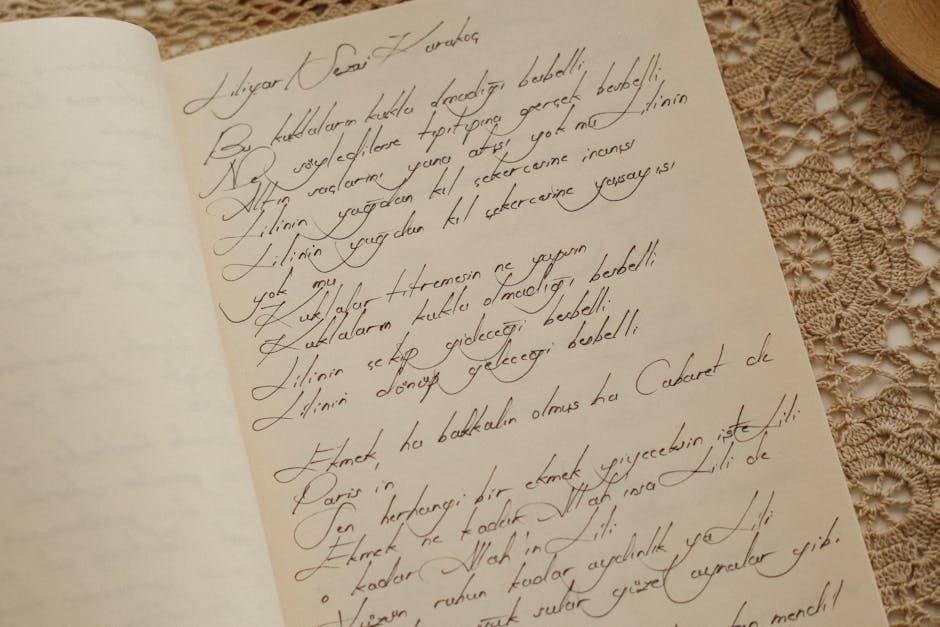Written by Edwin Arlington Robinson in 1897, “Richard Cory” is a narrative poem exploring themes of wealth, isolation, and the hidden truths behind appearances. The poem follows Richard Cory, a seemingly perfect gentleman, and contrasts his admired life with a tragic ending, inviting readers to reflect on societal perceptions and inner turmoil. Its concise structure and dramatic irony leave a lasting impact, making it a timeless commentary on human nature and class distinctions. The poem is widely studied for its profound message and emotional depth, offering insights into the complexities of human life. Available as a PDF, it remains a significant work in American literature.
Background of the Poem
Written by Edwin Arlington Robinson in 1897, “Richard Cory” is a narrative poem that offers a glimpse into the life of a wealthy, admired man and his tragic demise. The poem was first published in Robinson’s collection The Children of the Night and quickly gained attention for its thought-provoking themes. Inspired by Robinson’s observations of societal class divisions and human behavior, the poem reflects his interest in character studies and the complexities of human nature. Its concise yet impactful structure has made it a popular subject for analysis, with the full text available as a PDF for educational purposes. The poem remains a significant work in American literature.
Significance of the Poem’s Title
The title “Richard Cory” focuses attention on the protagonist, emphasizing his central role and the community’s perception of him. By naming him directly, the poem highlights the contrast between Cory’s outward appearance and his inner turmoil. The title also serves to underscore the universality of the themes, making Cory a symbol of the hidden struggles behind wealth and status. This simplicity in titling draws readers into the narrative, inviting them to explore the complexities of Cory’s life. The title’s directness complements the poem’s concise structure, making it memorable and thought-provoking. The full text, available as a PDF, delves deeper into these themes.

Themes in “Richard Cory”
The poem explores themes of social class, appearance vs. reality, and isolation. It contrasts Cory’s wealth with his inner sadness, highlighting societal illusions about happiness and status. The tragic ending underscores the gap between outward success and personal fulfillment, resonating with universal human experiences. The full poem, available as a PDF, delves into these themes deeply.
Exploration of Social Class
The poem vividly portrays the divide between the wealthy elite and the working class, using Richard Cory as a symbol of privilege. Cory’s refined appearance and demeanor contrasts sharply with the townspeople’s admiration and envy, highlighting social stratification. The narrator, part of the “people on the pavement,” observes Cory’s elegance and grace, emphasizing his superior status. However, Cory’s suicide challenges the notion that wealth ensures happiness, revealing the emptiness behind his polished exterior. This exploration critiques societal perceptions of class, suggesting that material wealth does not equate to fulfillment. The poem, available as a PDF, offers a poignant commentary on class disparities and human isolation.
Appearance vs. Reality
The poem masterfully explores the contrast between appearance and reality through Richard Cory’s character. Cory is described as a “gentleman from sole to crown,” admired for his elegance and refinement. His polished exterior and courteous demeanor create an image of perfection, making him the envy of the townspeople. However, this facade hides a profound inner emptiness, culminating in his tragic suicide. The poem challenges the notion that outward appearances reflect true happiness, revealing a stark disparity between Cory’s public image and private despair. This contrast underscores the idea that societal perceptions often mask hidden truths, a theme that resonates deeply in the PDF version of the poem.
The Theme of Isolation
The poem vividly portrays Richard Cory’s profound isolation despite his admired status. Cory’s wealth and polished demeanor create a barrier, preventing genuine connections with others. The townspeople envy his outward perfection but fail to see his inner loneliness. His courteous interactions mask a deep emotional void, highlighting the disconnect between his public image and private suffering. Even in death, Cory remains isolated, as his suicide shocks the community, revealing the unnoticed despair behind his composed facade. The poem underscores how isolation can exist alongside outward success, a theme that resonates deeply in the PDF version of the poem, inviting readers to reflect on the human cost of social barriers.

Poetic Structure and Style
Edwin Arlington Robinson employs a structured meter and rhyme scheme, creating a rhythmic flow that enhances the poem’s emotional depth. The imagery-rich narrative style vividly contrasts Cory’s polished exterior with his inner turmoil, while the concise language underscores the tragic irony of his isolated life. The poem’s tight structure amplifies its dramatic impact, making it a masterful exploration of human complexity, as evident in the PDF version available for deeper analysis.
Meter and Rhythm
The poem “Richard Cory” by Edwin Arlington Robinson features a consistent meter, primarily in iambic pentameter, which creates a steady and rhythmic flow. This rhythmic structure mirrors the orderly and polished life of Richard Cory, contrasting with the turmoil beneath his surface. The use of a regular meter enhances the poem’s musicality and contributes to its emotional impact. The rhythm builds anticipation, leading to the poem’s tragic conclusion. The meter and rhythm work together to convey the themes of appearance vs. reality and societal perceptions. This structure is evident in the PDF version, highlighting Robinson’s mastery of form.
Rhyme Scheme
The poem “Richard Cory” by Edwin Arlington Robinson follows a consistent rhyme scheme of abab, which contributes to its rhythmic and musical quality. This pattern enhances the poem’s flow and structure, making it memorable and engaging. The rhyme scheme supports the overall themes of appearance vs. reality and societal perceptions, as it creates a sense of order that contrasts with the tragic ending. The abab rhyme scheme is evident in the PDF version of the poem, where the rhyming words at the end of each line help emphasize key moments and emotions. This structure is a hallmark of Robinson’s poetic style and adds depth to the narrative.
Imagery and Symbolism
Edwin Arlington Robinson’s “Richard Cory” is rich in imagery and symbolism, creating vivid portraits of its characters and themes. The poem’s imagery, such as “a gentleman from sole to crown, / Clean favored, and imperially slim,” paints Cory as an epitome of elegance and refinement. His quiet attire and courteous speech symbolize his efforts to blend in, despite his wealth. The town’s admiration for Cory contrasts sharply with his tragic end, symbolizing the gap between appearance and reality. The final line, “Went home and put a bullet through his head,” is a stark symbol of hidden despair beneath a perfect facade. These elements are vividly presented in the PDF version of the poem, enhancing its emotional and thematic impact.

Analysis of Key Stanzas
The poem’s stanzas gradually reveal Richard Cory’s character and fate. The first stanza introduces Cory as an admired figure, while the second highlights the townspeople’s envy. The final stanza shockingly contrasts Cory’s outward perfection with his tragic end, emphasizing the disparity between appearance and reality. This structure builds suspense and underscores the poem’s themes, as detailed in the PDF version.
The first stanza introduces Richard Cory as a man of admiration and mystery. It describes his physical appearance and demeanor, highlighting his elegance and refinement. The use of “gentleman from sole to crown” and “imperially slim” creates an image of perfection; The stanza sets the tone for the poem, presenting Cory as a figure of envy and fascination. The townspeople’s gaze underscores his social status, while his quiet array and human speech suggest an approachable yet distant character. This initial portrayal contrasts sharply with the poem’s tragic conclusion, inviting readers to explore the hidden depths behind Cory’s polished exterior, as detailed in the PDF version.
Second Stanza: The Town’s Perception
The second stanza delves into the town’s admiration and envy of Richard Cory, highlighting their perception of his flawless life. His quiet elegance and refined speech captivate the townspeople, who see him as a symbol of perfection. The stanza emphasizes the contrast between Cory’s polished exterior and the underlying sadness, hinting at the emptiness beneath his privileged existence. The townspeople’s fascination with Cory’s wealth and grace underscores the societal idolization of material success. This perception, however, blinds them to the reality of his inner struggles, which the poem later reveals. The stanza’s tone reflects both admiration and subtle tension, as detailed in the PDF version of the poem.
Final Stanza: The Tragic Ending
The final stanza of “Richard Cory” delivers a shocking conclusion, revealing Cory’s tragic demise. The lines, “And Richard Cory, one calm summer night, / Went home and put a bullet through his head,” starkly contrast the town’s admiration with Cory’s inner despair. This abrupt ending underscores the poem’s exploration of appearance vs. reality, as Cory’s polished facade hides profound unhappiness. The stanza’s brevity intensifies its emotional impact, leaving readers grappling with the disparity between societal perceptions and personal truth. The tragic ending highlights themes of isolation and the emptiness of material wealth, resonating deeply in the PDF version of the poem.

Historical Context
Written in 1897, “Richard Cory” reflects the societal norms and class divisions of the late 19th century. The poem captures the Gilded Age’s contrast between wealth and isolation, offering timeless commentary on human nature and social expectations.
Edwin Arlington Robinson’s Life
Edwin Arlington Robinson, born on December 22, 1869, in Head Tide, Maine, was an American poet known for his insightful and often somber portrayals of life. Despite his talent, Robinson faced financial struggles early in his career, working various jobs to support himself. His break came when President Theodore Roosevelt, admiring his work, secured him a position at the New York Custom House, allowing him to focus on writing. Robinson’s poetry, including “Richard Cory,” gained critical acclaim for its depth and exploration of human nature. He became a three-time Pulitzer Prize winner and a leading figure in American poetry until his death on April 6, 1935.
Cultural Influences on the Poem
Edwin Arlington Robinson’s “Richard Cory” reflects the cultural and societal norms of the late 19th century, particularly the Victorian era’s emphasis on appearances and class distinctions. The poem critiques the societal pressure to conform to ideals of wealth and status, highlighting the disconnect between outward success and inner turmoil. The Industrial Revolution’s rise also influenced the poem, as it exacerbated economic disparities, evident in the contrast between Richard Cory’s affluence and the townspeople’s modest lives. These cultural dynamics shape the narrative, offering a timeless commentary on the human condition and the illusion of happiness tied to material wealth.

Download “Richard Cory” PDF
The full text of “Richard Cory” is available as a PDF, accessible from platforms like Google, Scribd, or Poetry.com. The file is compatible with mobile and desktop devices, ensuring easy reading and printing for academic or personal use. Download now to explore Robinson’s masterful exploration of human nature and societal illusions in this timeless classic.
How to Access the Full Poem
To access the full version of “Richard Cory,” visit reputable platforms like Poetry.com, Scribd, or academic databases such as EDX. The poem is freely available in PDF format due to its public domain status. Ensure compatibility by downloading the latest PDF readers. Use search terms like “Richard Cory PDF download” to locate it efficiently. Universities and online libraries also provide direct links for easy access. Save and print the file for offline reading or study purposes. This method guarantees a seamless reading experience and comprehensive understanding of Robinson’s work.
PDF Format and Compatibility
The “Richard Cory” PDF is universally compatible across devices, ensuring easy access on smartphones, tablets, and computers. The format preserves the poem’s original structure and readability. Most PDF readers, such as Adobe Acrobat or Google Drive, support this file type without issues. The document’s clarity and formatting remain intact, allowing readers to focus on the poem’s themes and imagery. Additionally, the PDF is lightweight, making it quick to download and share. Its compatibility ensures that anyone can enjoy Robinson’s masterpiece without technical barriers, enhancing the overall reading experience and accessibility for scholars and poetry enthusiasts alike.

Study Questions and Discussions
- What is the central theme of “Richard Cory”? How does the poem explore this theme?
- How does the poem’s mood shift throughout the narrative? What contributes to this shift?
- What role does imagery play in conveying the poem’s message?
- How does the rhyme and rhythm enhance the poem’s emotional impact?
- What shocked the townspeople most about Richard Cory’s fate? Why?
Understanding the Poem’s Message
The poem “Richard Cory” by Edwin Arlington Robinson presents a profound commentary on societal perceptions and the illusion of perfection. Through Cory’s tragic tale, the poem highlights the disconnect between outward appearances of success and inner emotional turmoil. It challenges readers to look beyond superficiality and recognize the isolation that wealth and status can bring. The poem’s message underscores the emptiness of materialism and the dangers of idealizing others without understanding their true struggles. This timeless theme encourages introspection and empathy, urging us to seek genuine connections over societal facade.
Reader’s Reaction to the Ending
Readers of “Richard Cory” often experience shock and disbelief at the poem’s tragic conclusion. The revelation that Cory, a man admired for his wealth and elegance, ends his life challenges the townspeople’s—and readers’—assumptions about his happiness. This twist evokes pity and curiosity, as it contrasts Cory’s outward perfection with his inner suffering. The ending prompts reflection on societal pressures and the illusion of fulfillment, leaving a lasting emotional impact. It also invites readers to question the validity of judging others based on appearances, making the poem’s conclusion both haunting and thought-provoking.
“Richard Cory” by Edwin Arlington Robinson is a poignant exploration of societal illusions and individual despair. The poem masterfully contrasts Cory’s outward elegance with his inner isolation, culminating in a shocking suicide that challenges perceptions of wealth and happiness. Through its concise yet powerful structure, the poem critiques class divisions and the facade of perfection, leaving readers with a lasting reflection on human vulnerability. Its enduring relevance continues to resonate, making it a vital study in American literature. The availability of the poem in PDF format ensures its accessibility for readers to engage with its profound message;